Readers note: This articles draws on unpublished material originally written for PDA Essentials magazine. The full, verbose, material appeared on AAS briefly at the end of 2005, while it appeared that PDAE had disappeared. Gladly, it's now been taken up by Imagine Publishing, who included most of my original text in issue 46, but not the photographic material below, which with the new text below can be considered a bonus article.
So there I was, a couple of months ago, with four of the hottest smartphone products on the market, two from the Symbian OS world (Nokia N90 and N70) and two from the Windows Mobile world (Orange M5000 and SPV C600), under commission from PDA Essentials to find out which was the best multimedia smartphone. Now, as part of the feature, I looked at overall performance, applications, integration and multimedia playback, concluding in the end that the Nokia N90 and N70 were superior to the two Orange offerings, with the special emphasis on the multimedia side of things.
But my photographic evidence for this feature had to be omitted for space reasons, and it seemed a shame to waste it. The difference in quality between Nokia's camera hardware and that of the competition was so marked, it just cried out for visual publication.
Still photography
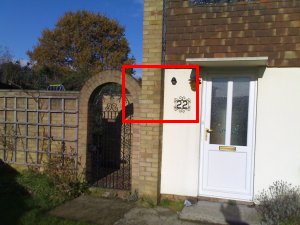
A simple one-off test, admittedly, but conditions were perfect. A bright wintry day, all the photographs were taken of the front of a house, standing in the same place, within the same half hour period. With detail on the bricks and gate, plus the challenge of managing the bright cream face of the house in the sun, the setting was a good test of the camera optics and software inside each smartphone.
In each case, I've used default (though with highest JPG quality) settings on each device - I simply don't believe users in the real world stop to fiddle with camera settings (e.g. contrast/tone) for 30 seconds every time they want to snap something. And in each case, I've cropped out the section outlined above, to show you in full detail. (Each original image would be far too large to include in a web page).
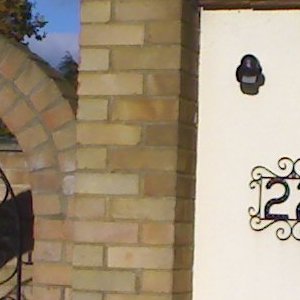
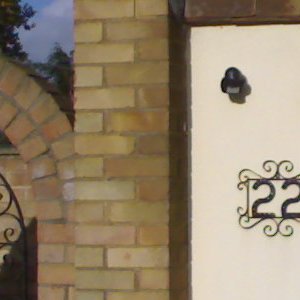
Photo fragments from the best imaging smartphones on the market, the Nokia N90 (left) and N70 (right). Note the terrific
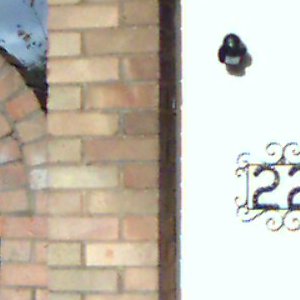
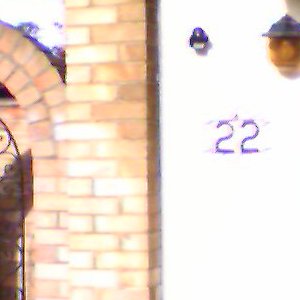
Photo fragments of the same scene, same conditions, on the Orange M5000 (HTC Universal/T-Mobile MDA Pro, left) and SPV C600 (right). Note the poorer handling of contrast and the lack of optical detail
Video capture
For video recording, I took some indoor (but in good lighting) footage and then grabbed a typical screen from the Quicktime playback on my PC. The images are full-size, i.e. this is the frame size/detail you'd see for real.


352 by 288 pixel screen grabs directly from video footage from the Nokia N90 (left) and Nokia N70 (right). In each case, provided there's not too much panning around and in good enough lighting, footage from the smartphone could be integrated into home video/DVD without too many adverse comments.


320 by 240 and 176 by 144 pixel screen grabs directly from video footage from the Orange M5000 (left) and SPV C600 (right). Note the smaller frame sizes and (again) poorer handling of contrast and detail. The M5000 was particularly disappointing, with poor frame rate and plenty of compression artefacts.
Summary
Comparing the N70 with the M5000 shows that there's more to good smartphone photography than simply a high resolution. There's a whole chain of hardware and software involved, from the quality of the lens used, to the quality of the CCD array. Then there's the electronics used to process the output from the array and finally the software used to encode the result in JPG format.
Results from the Nokia N90 show that the Carl Zeiss optics produce impressive detail, although the N70, surprisingly, wasn't that far behind, in good lighting. Photographing close-up subjects would show more of a difference, of course, as the N90 has a proper mechanically-focussing lens. In each case, I was pleasantly surprised by the relative 'near-VHS' quality of the video recording. Surely the time is not far off when full DVD-ready video capture can be done on a smartphone, meaning yet one more gadget you have to carry around.
It's difficult to say why the results from the two Orange-branded HTC devices were so poor. Probably the lens, the array, the electronics and the software are all slightly inferior to those in their Nokia N-series counterparts. Add the effects together though and the result is like night and day. It's not really an OS thing, I'm sure both Symbian OS and Windows Mobile are up tot he task, this is more about care and attention taken in design and manufacture.
Appendix: Specifications
Nokia N70
Display: 176 by 208, 262k colours, size 55mm diagonal, Size/Weight: 109 x 53 x 22mm / 126g, Camera still resolution:1600 by 1200, Flash: Yes, Camera video resolution:352 by 288, 15fps, Onboard flash memory:22MB available, Telephony:3G/EDGE/GPRS, Expansion card: DV RS-MMC, OS:Symbian OS 8.1, Series 60 2.8 Feature Pack 3
Pros: Very good camera, good video recording capability, robust one-piece design
Cons:Low resolution screen, clunky PC music integration
Nokia N90
Display: 315 x 416 x 262k colours, size 55mm diagonal, Size/Weight: 115 x 54 x 21mm / 173g, Camera still resolution:1600 by 1200, Carl Zeiss optics, macro, auto-focus, Flash: Yes, Camera video resolution:352 by 288, 15fps, Onboard flash memory:30MB, Telephony:3G/EDGE/GPRS, Expansion card: DV RS-MMC, OS:Symbian OS 8.1, Series 60 2.8 Feature Pack 3
Pros: Great camera, good video recording and all other multimedia functions
Cons:Slightly fiddly, easy to drop, poor battery life
Orange SPV C600
Display: 320 x 240 x 64k colours, size 56mm diagonal, Size/Weight: 105 x 48 x 20mm / 110g, Camera still resolution:1280 by 1024, Flash: No, Camera video resolution:176 by 144, 15fps, Onboard flash memory:64MB, Telephony:GPRS, Expansion card: mini SD, OS:Windows Mobile 5.0
Pros: Small and light, looks great, well designed, good for music
Cons: Poor camera, very poor video recording, disappointing video playback
Orange M5000
Display: 640 by 480, 64k colours, size 90mm diagonal, Size/Weight: 128 x 81 x 25mm / 285g, Camera still resolution:1600 by 1280, Flash: Yes, Camera video resolution:320 by 240, 10fps, Battery life (Talk time): 4 hours, Onboard flash memory:44MB, Telephony:3G/GPRS, Expansion card: SD, OS:Windows Mobile 5.0
Pros: Large screen, superb keyboard, good battery life
Cons: Very disappointing for video and fiddly for music. Relatively heavy and bulky.
